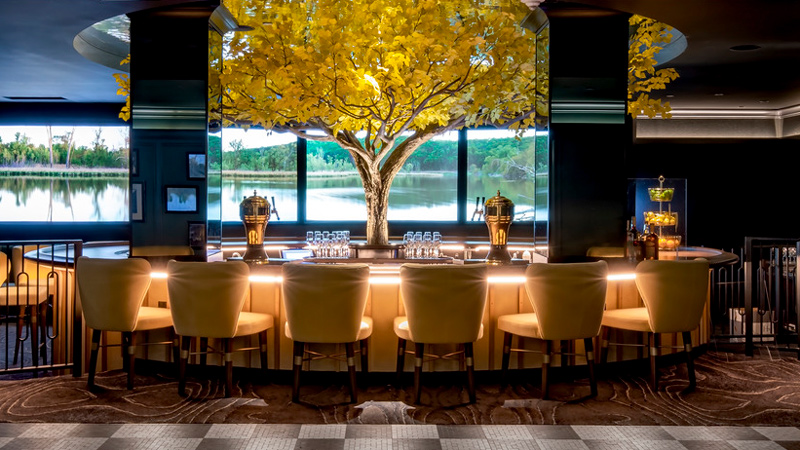Recent Articles
Mother (Nature) knows best
Sustainability intern Lillia Blasius explores biophilia, biomimicry and the crossover between environmental biology and design

As an environmental biology major at Purdue University, I came into my LEO A DALY internship excited to learn how my experience studying natural systems could fit into the work of a design firm. Working with Chief Sustainability Officer Ellen Mitchell-Kozack, I’ve spent the last few months helping to develop resources that make it easier for planners, architects, engineers and interior designers to harness biophilia (human connection with nature) and biomimicry (the use of natural patterns and systems) in their work.
As new challenges arise due to climate change, it’s more important than ever to evolve our approach to and relationship with the natural world. Biophilia and biomimicry are incredible resources in this effort, allowing designers to pull ideas from a natural system that has adapted and evolved for billions of years. As I’ve learned, designers at LEO A DALY believe that understanding and mimicking strategies found in nature will be critical to solving the ecological and human challenges we will face in years to come.
In this blog, I’ll share some of the ways designers can look to the natural world for cues in designing healthier, more resilient and more sustainable environments for humans.
What is biophilia?
Biophilia is the innate connection humans have with the natural environment. We spend, on average, 90% of our time inside. That’s a lot of time away from our evolutionary home! The way a space is designed, inside and out, can help reestablish that biophilic connection we crave.
According to environmental psychology studies, spending a few minutes a day in nature, or surrounded by nature-like qualities, has impactful human health benefits. It has been found to lower anxiety/depression, stress levels, and blood pressure, while also increasing the likelihood of exercising and benefitting overall health and well-being. Biophilic elements have also been found to increase productivity, focus, and creativity.

Biophilic design can be broken into direct and indirect elements. Direct biophilic elements are any element of nature that can be directly added to a space – air flow, sun exposure, visible/audible water, native plants, and landscape, for example. Indirect biophilic elements can be represented by photos or paintings of nature, natural building materials and colors, natural shapes, forms and geometries.
These elements are important to add in abundance. One plant on your desk will have little impact, but creating a cohesive environment with plenty of these qualities threaded throughout it will make a big difference for occupants. Organized complexity, areas of refuge, transitional spaces and ecological connections can add up to a more nature-like environment while remaining comfortable. Cultural connections and creating a sense of security make a space personal and allow individuals to relate and feel at home.
Biophilia in healthcare
In healthcare settings, biophilic elements have long been acknowledged as Evidence Based Design strategies for improving outcomes. Including elements of nature into patient rooms, waiting areas, staff lounges and office spaces is beneficial to patients, visitors and staff alike.
A study by Ulrich discovered that, after a major surgery, individuals who recovered in a room with a view were released in 7.96 days verses the 8.71 days of patients who recovered in a room with no view. In addition to faster recovery, this 8.5% decrease in hospital stay reduces the cost of healthcare significantly. A study by Walch et al. identified that when patients were exposed to greater amounts of sunlight, they took 22% less analgesic medications per hour and had a 21% lower medication bill by the end of their stay.
Healing gardens placed on hospital grounds have powerful impacts as well, giving patients and visitors an opportunity for exercise, a venue for social support and a moment of respite from intense emotional experiences. They double as a resource for stressed hospital staff and screen-weary office workers.
Biomimicry in resilience and sustainability
Biomimicry is the application of nature’s engineering and resources into our built environment. Nature constantly is adapting and evolving to environmental conditions, which means we can look to nature as a guide for building sustainability and resilience.
One example: a trio of Industrial Design students at California State University, Long Beach created an insulation device taking inspiration from termites, camels, Saharan silver ants, wheat, and cacti. The system, called Phalanx, is applicable to current building exteriors and aims to keep buildings cool. It is made up of three layers: a first to reflect sunlight, a second to direct hot air flow up and out, and a third to cycle graywater/rainwater against the outside of the building, ultimately cooling it down.
Another example: Sensitive Wall by Taiwan’s ARCHI-Farmer takes design inspiration from concave-eared torrent frogs, mimosa leaves, and desert snails to create a green sound barrier. In rapidly growing urban environment marked by frequent heat waves and increasing levels of traffic and noise, the solution provides a noise barrier from traffic and a greenery wall that adds both landscaping and cool shade perfect for urban restaurants, parks, schools and shopping areas.
By looking at how nature adapts and builds its ‘infrastructure’ we can build a more resilient built environment that will not only last longer, but reduce our environmental footprint, improve climate change efforts, save money, and benefit those in the community surrounding it.
More resources on biophilia and biomimicry
 As nature adapts to change, it shows us solutions to problems we currently face within our built environment. Here are some additional resources to learn more about both biophilia and biomimicry:
As nature adapts to change, it shows us solutions to problems we currently face within our built environment. Here are some additional resources to learn more about both biophilia and biomimicry:
- Solutions – Biomimicry Institute
- Professional Training – Biomimicry 3.8
- What Is Biomimicry? – Biomimicry Institute
- The Practice of Biophilia – Biophilia Foundation
- About Us – Biophilia Foundation
- 14-Patterns-of-Biophilic-Design-Terrapin-2014e.pdf (terrapinbrightgreen.com)
- Biophilia, the future of architecture | Matthias Olt | TEDxSeattle – YouTube
- Second Nature ‘The Biomimicry Evolution’ Trailer – YouTube
- Janine Benyus: Biomimicry in action | TED Talk

About the author
Lillia Blasius is a sustainability intern with LEO A DALY and a student of ecology, evolution, & environmental biology at Purdue University.



